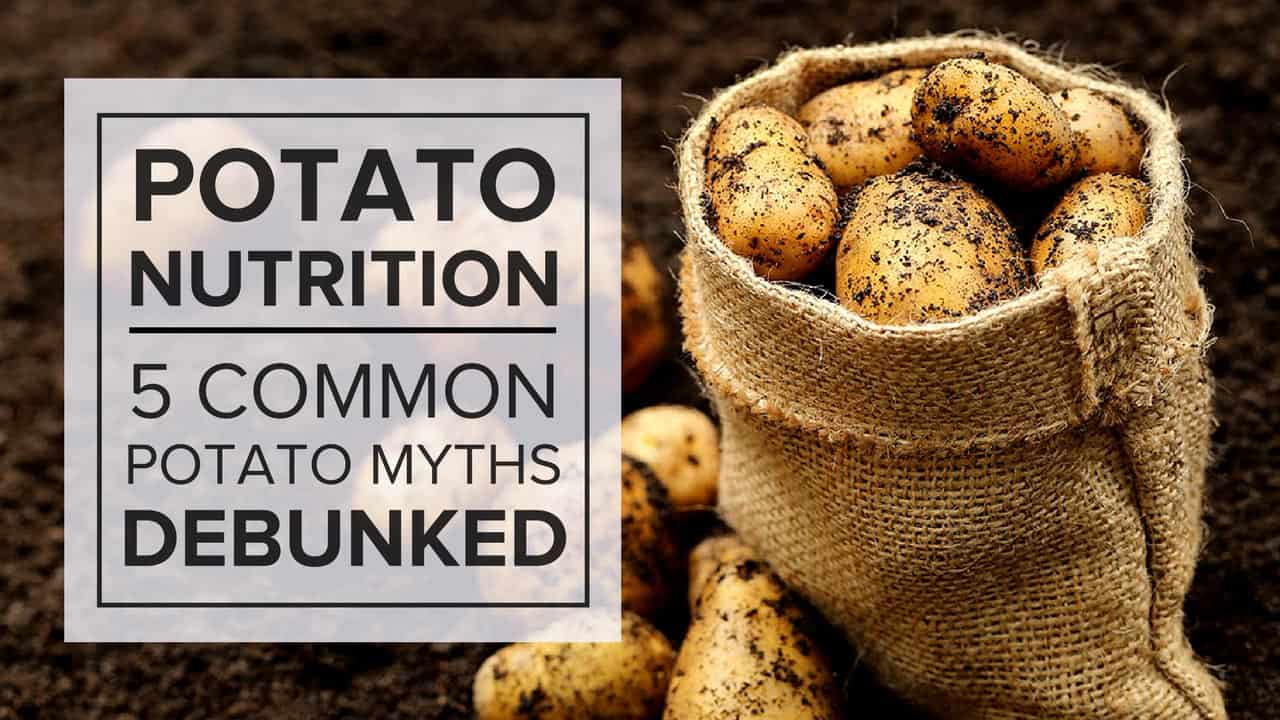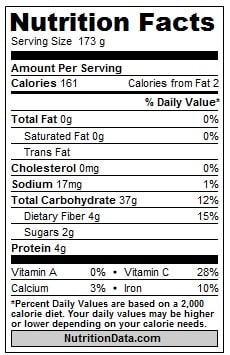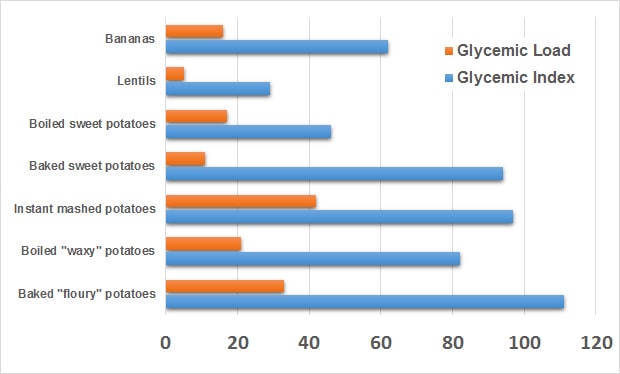
If you're like most people, you may be on the fence about whether potatoes are actually good for you. Understanding potato nutrition has become overly complex, and unfortunately the truth about these starchy vegetables has become overly complicated.
Riddled with such claims as “potatoes are too high in carbohydrate” or “potatoes have a high glycemic index,” it has become downright confusing to determine whether potatoes are worth keeping in your diet, or whether they belong in your trash can.
In this post, we’ll address 5 common potato myths and get to the bottom of potato nutrition so that you know the truth.
Spoiler alert: potatoes are extremely good for you.
Myth #1: Potatoes Are High in Carbohydrates and Will Spike Your Blood Glucose
You’ve heard it before.
“Carbs are bad for you."
“Carbs will make you fat.”
"Carbs are high in sugar.”
"Carbs are converted to fat.”
If you believe any of these statements, then it’s not your fault. Since the advent of the Atkins diet, America has been fed a host of anti-carbohydrate propaganda.
Let’s establish a few things first:
- Carbohydrates are a fuel for all tissues in your body
- Your brain runs off of glucose for 99.99% of your life
- Carbohydrates are stored as glycogen in your muscles, for use during exercise
- Carbohydrates are stored as glycogen in your liver, to provide your brain with a drip-feed of glucose 24 hours a day
- Carbohydrates are converted into fat, but at a terribly slow and inefficient pace in the human body (2)
Take a look at the nutrition facts label shown here for a medium white potato (3):

You may notice a few things:
- A single medium white potato contains about 150 calories
- A single medium white potato contains about 40g of carbohydrate
- A single medium white potato contains about 5 grams of protein
- A single medium white potato contains almost no fat
Many people with diabetes will pass up white potatoes, sweet potatoes and yams because they are high in carbohydrates, fearing that they will skyrocket blood glucose.
Instead, they opt for low-carbohydrate options, often eating foods that contain a large amount of protein or fat, fearing that potato nutrition is not on their side.
Carbohydrate-rich foods like potatoes can spike your blood glucose if the fat content of your diet is already high. Adopting a low-fat diet significantly increases your carbohydrate tolerance, allowing you to eat more potatoes without negatively affecting your blood glucose.
Myth #2: All Potatoes Are Nightshade Vegetables
Sounds scary, right?
Nightshade vegetables are a class of vegetable that are high in their alkaloid content. Some people have a sensitivity to alkaloid compounds, resulting in a host of frustrating health conditions, including (but not limited to):
- Arthritis-like symptoms
- Headaches
- Depression
- Gas
- Diarrhea
- Bloating
- Nausea
Some people believe nightshade vegetables are harmful because they’re confusing them with “deadly nightshade.” When consumed in large amounts, deadly nightshade may cause convulsions or even death (1).
But even regular nightshades such as potatoes contain toxic alkaloids, right? Wrong.
Many alternative medicine websites claim that nightshade vegetables contain a toxic alkaloid compound called solanine.
Solanine is a defense mechanism in some Solanaceae plants, used to protect against natural threats such as insects and small animals.
You’ll see this effect when the potato has green spots (which also happens when it’s exposed to light during growth). That’s why you grow your potatoes in shady areas or buy potatoes without green spots. Simple solution.
The truth is that only a small percentage of people actually have an intolerance for nightshade vegetables. The majority of people don't react to nightshade vegetables, making this potato-aversion completely unnecessary.
More importantly, not all potatoes are in the nightshade family. Only white, red, yellow, and blue-skinned potatoes are nightshades.
Sweet potatoes and yams are not nightshades, therefore you do not need to worry about unwanted health threats.
Myth #3: Potatoes are Dangerous Because they are High on the Glycemic Index Scale
The glycemic index and glycemic load were invented to measure how fast and how much a food converts to glucose in your body.
The Glycemic Index (GI) is a measure of how quickly a food converts to glucose.
This is fine for foods that you eat as standalone snacks, such as apples, oranges and bananas. But for the potato? Potatoes are rarely eaten by themselves. They are usually part of a meal. This is where the glycemic load comes in.
Glycemic Load (GL) is a measure of how much a food converts to glucose. It turns out that the GI and GL are affected by several factors; most notably food preparation (4).
We all know that baking, boiling, and roasting foods such as potatoes is much healthier than frying. And deep frying is associated with more health concerns than any other method.
Aside from the added fat, deep frying potatoes can lead to the formation of acrylamides, which have been shown to increase your risk of cancer (5–7).
But why is this? Does deep frying potatoes affect their glycemic index? Most definitely.
And this is one of the key reasons why the glycemic score is flawed at it’s core. Most people don’t take into account the total glycemic load once the food is prepared, rendering the glycemic score effectively useless.
This chart compares the glycemic score of white potatoes to sweet potatoes, compared with lentils and bananas (high GI foods):

Myth #4: Potatoes Contain Starch and Starch is Bad for You
In order to digest the starch in potatoes, your body breaks down this starch and releases it as free glucose in your blood. This process takes time and a significant amount of digestive energy.
Fiber is a key player that helps slow the rate at which starch is broken down into glucose. But not all that starch gets converted to glucose.
A medium sized spud contains about 79% water and 4 grams of fiber, which is enough to significantly slow the process and reduce the rate at which glucose enters your blood.
Fiber from whole, unprocessed foods helps aid in satiation, especially when combined with water. That’s why you get full when eating high fiber foods – the fiber expands when interacting with water.
Foods that are high in starch like potatoes, squash and corn are actually very healthy for you and provide a long-lasting drip-release of glucose into your bloodstream to provide a constant energy supply for tissues all throughout your body.
Don’t be fooled into believing that starchy foods are bad for you and that they should be avoided. Eat starch-rich foods plentifully and prepare for sustained energy and fantastic blood glucose.
Once again, potato nutrition is on your side.
Myth #5: Potatoes Are Low in Micronutrients
When talking about micronutrients, I like to use the acronym WAV-FM.
WAV-FM is used to describe whole foods that are high in:
- Water
- Antioxidants
- Vitamins
- Fiber
- Minerals
The best way to get all of these nutrients from food is to eat whole, unprocessed foods. We’ve already touched on the water and fiber components of potatoes, making them a nutritious food choice. But what about their antioxidant, vitamin, and mineral content?
Potatoes have a large vitamin and mineral content. They contain vitamins A, C and E, and these vitamins protect against aging, aid in skin repair, maintain optimal liver health, and flood your blood with essential antioxidant compounds.
Antioxidants are potent chemicals in plants that help control oxidative damage (hence anti-oxidants) in your body. They also help regulate your immune system, protect you against viruses and reduce inflammation in tissues all throughout your body.
To understand this more, consider the following analogy:
Antioxidants protect plants from ultraviolet radiation from the sun in the same way that melanin protects our skin from the sun. In both plants and animals, pigments are colors. And colors are antioxidants. That’s exactly why your mom told you to eat the rainbow, because the rainbow is anti-inflammatory.
Most of the antioxidants in a potato are found in the skin, so eat the potato skin whenever you have the option. Your tissues will love you for it.
Take Home Message
Even though potatoes get a bad name for being high in carbohydrate energy and low in nutrients, don't believe the hype.
The truth is that potato nutrition is on your side – these root vegetables are nutrient dense, filling, and will keep you full for a long period of time without spiking your blood glucose, as long your total fat content is low.
Lower Your A1c and Get to Your Ideal Body Weight ... Guaranteed

Your results are guaranteed. Join more than 2,000 members today
Personalized coaching puts you in immediate control of your diabetes health, helps you gain energy, improves your quality of life, and reduces or eliminates your meds.
References
Leave a Comment Below
Share your thoughts and experience with potatoes below!

